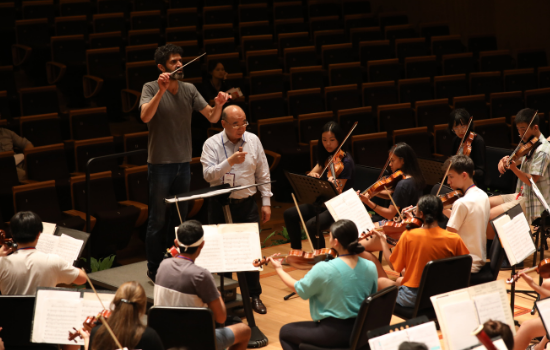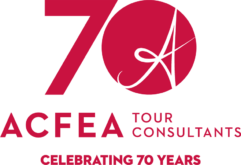As musicians, music is one of the major ways we communicate and explore the world. Catherine John, ACFEA Tour Administrator, talks about getting to know a new place by learning about its music, from its people.
***
In faraway lands, North American musicians encounter instruments that they have never seen or heard at home. These instruments are indigenous to the local people and culture, and on many occasions tour participants have had the chance to view demonstrations of these instruments or even try playing them.
The Colorado Children’s Chorale visited a Hutong, or traditional neighborhood, on their tour of China. During this visit, their hostess demonstrated the Guzheng (Chinese zither), singing and playing “Mo Li Hua” (“Jasmine Flower”) to the rapt young choristers.
Director Debbie De Santis remarked that the Hutong experience “was definitely a highlight of our tour – a step back in time and a break from the high rises and frenzy of the big cities.”
In Peru, touring groups partake in an Andean music workshop led by a professional musician and ethnomusicologist. Following a presentation and demonstration of traditional Andean instruments, participants are given their own zampuña (pan flute) on which they learn some basic techniques and take home as a souvenir. In Australia, groups have engaged in similar demonstrations of the digeridoo, and in New Zealand, tour participants have taken a workshop in the traditional Maori ‘Haka,’ which is not a musical instrument but a ceremonial war dance.
Ensembles have also enjoyed workshops with local directors who impart their native musical traditions through the art music genre that is familiar to the participants. In Honolulu, Hawaiian choral director Nola Nahulu led Portland Symphonic Girlchoir’s Intermezzo in a workshop of native Hawaiian choral music with a hula component that had the girls moving with the beautiful island music as they sang. In South Africa, the Young Women’s Chorus of San Francisco had a workshop with Mbuso Ndlovu just hours after landing in Johannesburg. Director Susan McMane recounted, “It was very inspiring when he took out his drum and began to play with our singing. Our choristers immediately knew that we were working with a master teacher and performer and they wanted to get everything they could from the experience … He demonstrated such a love of South African choral music with his amazing voice and rhythmic moves and drumming. His generous spirit and expertise energized and encouraged how we performed for the rest of the tour.”

Portland Symphonic Girlchoir Intermezzo after a workshop of native Hawaiian choral music with Hawaiian choral director Nola Nahulu. Photo courtesy Catherine John
Sometimes, groups on tour have the chance to form a more in-depth relationship with a director or composer of the country they tour. The Oakland Symphony Youth Orchestra had been preparing the piece “The Rhyme of Taigu,” by Dr. Zhou Long, for their China tour. After performing the piece in Beijing and Xi’an, the group received a special treat when Dr. Zhou himself agreed to extend his stay in Shanghai to work with the orchestra at their dress rehearsal, giving comments from the podium. According to Director of Education Warren Williams, “this was a welcomed challenge for our percussionists, who were playing traditional drums.”
Following their rousing performance of “The Rhyme of Taigu” at the Shanghai concert, the orchestra performed two encore pieces of Chinese folk songs arranged by Dr. Zhou, which were well received by the Shanghai audience. Williams remarks that the collaboration with Zhou Long was “an enriching experience for our youth and important moment of cultural ambassadorship, celebrating 40 years of diplomatic relations between our two nations.”

Dr Zhou Long listens at a Oakland Symphony Youth Orchestra rehearsal, prior to their concert at Shanghai Oriental Arts Center. Photo courtesy Dr Zhou Long.
Perhaps the most significant cultural and musical exchange of all occurs when a touring ensemble has the chance to make music with local people. When people of different cultures who have different backgrounds and who don’t necessarily speak the same language come together to make music, those initial barriers are broken down and people communicate at a deeper level.
Our groups have experienced this musical communitas in countless countries over the years, in particular at gatherings such as the Tallinn Song Festival. But such a musical and cultural connection can happen right here in the USA, too. The Garfield High School Orchestra of Seattle, WA, traveled to Los Angeles, CA to meet the Youth Orchestra of Los Angeles, an El Sistema-inspired music education program of the Los Angeles Philharmonic. Each orchestra played for the other, and then the two came together to work through common repertoire.
ACFEA Domestic Tour Manager Cassidy Massey remarks, however, that “at lunch is when things became special! Both groups came outside and grabbed their pizza and ate on the lawn. What surprised me was that the groups mingled and did not segregate themselves at all. They immediately started forming connections and having conversations. I assumed that the teenagers would be shy and keep to their own social groups. It was really nice to see them start bonding without hesitation.”
When it was time to leave, the teen musicians lingered as long as possible to exchange phone numbers and snapchats. The two orchestras had formed friends for life over two different states. In our ever more connected world, it is likely that the participants will stay in touch and come together again some day for musical collaborations.

